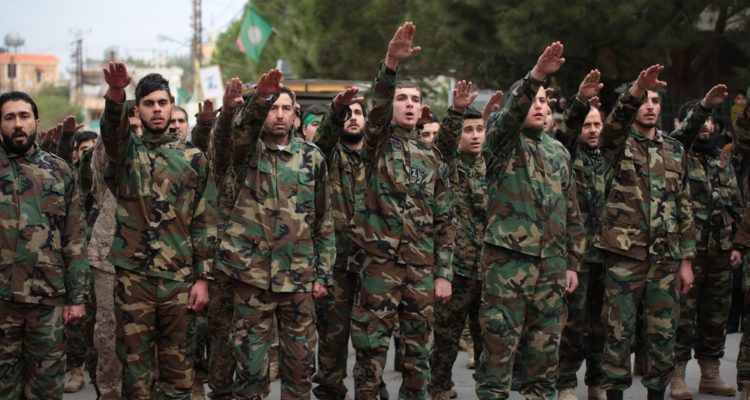The use of UAVs by Iranian-backed militias is part of a broader strategy to exploit asymmetrical warfare techniques and keep Israeli air defenses busy.
By Yaakov Lappin, JNS
Iranian-backed Shi’ite terrorist militias in Syria and Iraq are consistently using long-range unmanned aerial vehicles to target Israel’s Red Sea city of Eilat on a regular basis.
These UAVs, launched from bases in areas where Iran has entrenched itself, represent a persistent threat to Israeli security and will require more than defensive action to neutralize.
On Saturday, two UAVs approached the area north of Eilat from Syrian territory. The Israel Defense Forces intercepted the drones before they could inflict any damage, according to the military.
In retaliation, the IDF launched strikes overnight Sunday against a Syrian military command center and infrastructure sites, including targets used by the Syrian military’s Aerial Defense Unit.
It is possible that the sites hit by Israel in Syria were also used by Hezbollah, which has for years entrenched itself within Syrian military positions near Israel.
Israel’s policy of holding the Syrian regime accountable for all terrorist attacks emanating from its territory is logical but will not actually remove the threatening capabilities. Only Israeli strikes on the Shi’ite terrorist entities themselves in Syria and Iraq will do that.
Iran has been activating its militias in Syria and Iraq against Israel, as well as the Houthis in Yemen, since the start of the current war, as part of a multi-front assault.
On March 31, a UAV launched from Iraq entered Israeli airspace via Jordan and caused light damage to a naval base building in Eilat. The Islamic Resistance in Iraq (al-Moqawamat al-Islamiat fi al-Iraq) claimed responsibility for that attack, describing it as a strike on a “vital target” in Israel.
The use of UAVs by Iranian-backed militias is part of a broader strategy to exploit asymmetrical warfare techniques and keep Israeli air defenses busy.
This is all happening as Iran’s chief regional terrorist army, Hezbollah, rains down UAVs, rockets and anti-tank missiles on northern Israel, and absorbs Israeli fire in response.
Low-cost, high-impact
UAVs provide Iranian proxies with a low-cost, high-impact means of striking targets within Israel. They often fly at low altitude to try and evade detection by radar systems, and travel long distances, as was the case in the September 2019 attack on two major Saudi oil installations.
That attack involved UAVs fired, according to American assessments, from Iran, and traveling long and indirect routes to their targets in Saudi Arabia.
The Houthis later claimed responsibility for those attacks, likely to try and cover up Iran’s decision to launch the drones itself.
The latest drone attacks from Syria and Iraq indicate a coordinated Iranian effort to create a multi-front threat against Israel, one that, without a direct offensive response, will only grow, irrespective of the nature of the Syrian regime’s complicity, whether active or passive.
Iranian terrorist militias, equipped with increasingly sophisticated UAV technology provided by Iranian defense industries, pose a direct threat not only to Israel but to Sunni Arab countries as well, including Jordan and the United Arab Emirates.
The IDF’s interception of the UAVs near Eilat demonstrates the effectiveness of Israel’s world-leading multi-layered air defense systems, which include the Iron Dome, David’s Sling and Arrow systems.
Israel may have to adopt new capabilities as well, such as radar-guided cannon, to help take on larger drone swarms, which appear to be only a matter of time.
The new Israeli Iron Beam laser cannons can provide a valuable and cheap layer of local defense.
But Israel cannot disregard the need for consistent offense.
In Syria, Iran maintains thousands of Shi’ite terrorists as it tries to build a new army there, such as the Fatemiyoun Brigade Afghan Shi’ite militia and the Zainebiyoun Brigade Pakistani Shi’ite militia.
These forces are equipped, trained, and activated directly by the Quds Force of Iran’s Islamic Revolutionary Guards Corps.
Meanwhile, it is the IRGC’s own Aerospace Force that fires drones and missiles directly from Iranian territory, including at Israel on April 14 this year and during the 2019 attack on Saudi Arabia.
The Islamic Resistance in Iraq, which said it was behind the March 31 Eilat attack, is an umbrella organization composed of several Iranian-backed Shi’ite militias, including Kata’ib Hezbollah, Harakat Hezbollah al-Nujaba and Kata’ib Sayyid al-Shuhadaa.
These groups operate both in Iraq and Syria under IRGC command.
The build-up of these militias has accelerated in recent years, even as reports on occasional airstrikes against them have surfaced.





